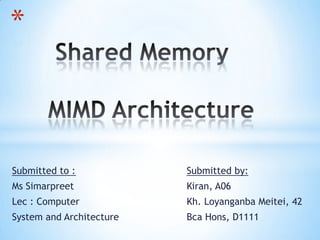
Mimd
- 1. * Submitted to : Submitted by: Ms Simarpreet Kiran, A06 Lec : Computer Kh. Loyanganba Meitei, 42 System and Architecture Bca Hons, D1111
- 2. * *Types of shared memory *Physically shared memory *Virtual (or distributed) shared memory *Scalability issues *Organisation of memory *Design of interconnection network *Cache coherence protocols 2
- 3. Multi-processor: Structure of Shared Memory MIMD Architectures
- 4. Design space of shared memory computers Shared memory computers Interconnection Cache coherency Single address space scheme memory access Hardware Virtual shared Shared path Software based Physical shared based memory Switching memory UMA network Singled bus based Multiple bus Crossbar Multistage network NUMA based Bus multiplication CC-NUMA Grid of buses Omega Banyan Benes Hierarchical COMA system
- 5. *
- 6. * *Also called distributed shared memory architecture *The local memories of multi-computer are components of global address space: * any processor can access the local memory of any other processor *Three approaches: * Non-uniform memory access (NUMA) machines * Cache-only memory access (COMA) machines * Cache-coherent non-uniform memory access (CC-NUMA) machines
- 7. *
- 8. * *Logically shared memory is physically distributed *Different access of local and remote memory blocks. Remote access takes much more time – latency *Sensitive to data and program distribution *Close to distributed memory systems, yet the programming paradigm is different *Example: Cray T3D
- 9. *
- 10. *
- 11. * *Each block of the shared memory works as local cache of a processor *Continuous, dynamic migration of data *Hit-rate decreases the traffic on the Interconnection Network *Solutions for data-consistency increase the same traffic (see cache coherency problem later) *Examples: KSR-1, DDM
- 12. *
- 13. * *A combination of NUMA and COMA *Initially static data distribution, then dynamic data migration *Cache coherency problem is to be solved *COMA and CC-NUMA are used in newer generation of parallel computers *Examples: Convex SPP1000, Stanford DASH, MIT Alewife
- 14. * + No need to partition data or program, uniprocessor programming techniques can be adapted + Communication between processor is efficient + Minor modifications of tool chain and compiler - Synchronized access to share data in memory needed. Synchronizing constructs (semaphores, conditional critical regions, monitors) result in nondeterministic behavior which can lead programming errors that are difficult to discover - Lack of scalability due to (memory) contention problem
- 15. * *Memory Access Time * can be a bottleneck even in a single-processor system *Contention for Memory * two or more processors want to access a location in the same block at the same time (hot spot problem). *Contention for Communication * processors should share and use exclusively elements of the Interconnection Network *Result: long latency-time, idle processors, nonscalable system
- 16. * *Problems of scalable computers 1. Tolerate and hide latency of remote loads 2. Tolerate and hide idling due to synchronization *Solutions 1. Cache memory * problem of cache coherence 2. Prefetching 3. Threads and fast context switching
- 17. *
- 18. Than ks...
